 |
 |
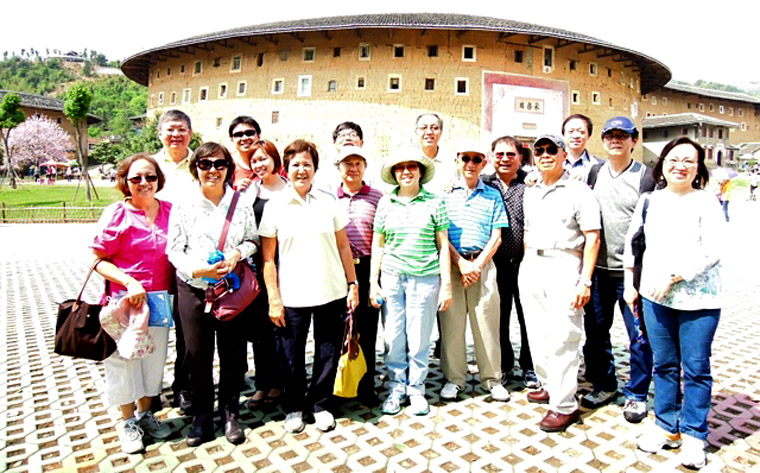
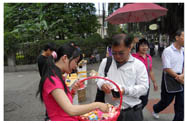 |
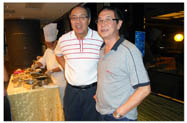 |
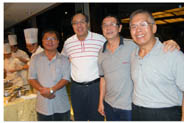 |
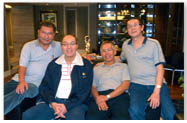 |
This year, our China sojourn did not receive the usual enthusiastic
response, we tagged onto a family trip, Gan Khai Choon’s family
trip, his sisters and their spouses. Besides me were Soo Cheng and wife
Hancy, and Hwang Theng Khing who provided (besides being unpaid guide)
the light moments and insight to China and Hong
Kong.
I discovered that our Penang popiah, lor bak and oh chian (their flavour in Penang evolved though) originated from Xiamen, many Hokkiens in Penang have their roots in Xiamen. Hokkien is spoken widely in Xiamen.
We spent four days in Xiamen (formerly called Amoy) and visited the “Hakka roundhouse” (a heritage site). This is a robust (mortar and brick somewhat like the material found in the Great Wall), round structure of about 5 storeys high with only an entrance and an exit and inside is a community of people, up to 700 inhabitants living there, all in concentric circles. Imagine a medieval castle in Europe, it’s also for safety and protection.
Xiamen was the city that Admiral Cheng Ho (Zhang He) set sail on his voyages to the “south seas” (Nanyang) and to Malacca at that time, reached up to Ceylon (Sri Lanka). There’s a museum dedicated to him. Researchers are trying to substantiate claims that he reached America in one of his voyages before the European voyagers Christopher Columbus.
Every meal was a treat, even in the long 3 hour trip to see the Hakka roundhouse which the hotel packed 5-star grade sandwiches for us to eat on reaching this isolated location. In those eight days I forgot what MSG (monosodium glutamate) taste like! We even had “teh tarik” and “ban chiang kueh” prepared in front of us in our hotel in Hong Kong.
Khai Choon told us that Cheng Woh has talked about visiting Hong Kong to try out the “dim sum” but he still has not shown up yet!
I have changed my opinion about Hong Kong, it’s a world class city! Some old parts but clean, orderly and I feel safe even walking on my own in the side roads of the touristy Nathan Road. The public transportation is very comprehensive and efficiently integrated, you cannot get lost. Communication is easy in Cantonese and English. Cost of living is also as world class though!
Soo Cheng his wife Hancy and I had a hurried beef noodle lunch in a hole in the wall eating place. He walked up to the counter to pay, and I (in typical Malaysian style) I also walked quickly to the counter to offer to pay, but was told off by the server (in Cantonese), “One person doing the paying will do, you go outside to wait there for him.” I swear I could hear him muttering under his breath, “Bloody nuisance, blocking the way, get out quickly…………..” This is Hong Kong! J
We made a side trip to Macau, Vegas of the east, many casinos, giant sized ones, including The Venetian, gondolas, singing and all, we dined in the replica courtyard of a famous Italian square (don’t remember the name). I was told some of the casinos are “better” than Vegas being newer, we did stroll through the gambling areas but it was of no interest to me. Lunch was a sumptuous Portuguese fare. We strolled through the area where lots of cookies are sold. Saw Portuguese tarts and realised “Portuguese tarts” was genuine Portuguese, not created by an imaginative Malaysian to market his creation.
We saw a show “Water Dance”, a Cirque De Soleil with water and a 5 Olympic pool sized pool as it’s theme, the water disappears in seconds for the non- water aero/acrobatics. Props appear astonishingly from the pool! Most of the performers (they will put many gym rats to shame!) are Caucasian except the main lady who looks oriental. There’s also a group Africans, very acrobatic! I have not watched Cirque De soleil, but I am sure this is as good and world class too.
My main impression, there’s no stopping China! In my lifetime, I will see China overtake most of Europe. Walking along the streets, iPhones and Blackberrys are everywhere, the ordinary people brimming with confidence.
from LCM
Read what Khing has to say:
My little contribution of our sojourn in Xiamen with a bit of research.
We visited , some perfunctorily,
(i) Fujian YongDing Haka Mud houses,
(ii) Xiamen Fort & University,
(iii) GuLangYu
(iv) Quanzhou Museum &
(v) Jimei University, secondary sschool. primary school and Tan Kah Kee
Memorial
It is Piazza San Marco (St. Mark's square), most notable square in
Venice especially for the carnevale in masquerade balls where
masks are worn in February/March each year. often depicted by paintings
of famous Italian painter Canaletto.
We could well do with our Chinese Styled Carneval with Chinese Operas
in all the old cities in China.
What can be done is in Xiamen and Hangzhou, the entrepot, and city
canals which Marco Polo learnt so much from architecture and gastronomy
e.g. pastas.
Gulangyu Island Statue facing Xiamen where a dialect of Hokkien, (Ming
Nang is spoken, has developed by leaps and bounds since the shackled
days when Gulangyu (Drum Wave Islet" (鼓浪屿) became a treaty port
resulting from China's loss in the First Opium War and the Treaty of
Nanking in 1842.
International collaboration with Xiamen University where students and
academics from many parts of the globe have come to learn, teach or to
do research has put Xiamen on the map.
Xiamen University in addition to the Jimei University, both have bee
funded by a Singaporean (Malayan) philanhropist of Xiamen decent,
Tan Kah Kee in 1921.
We also visited the Huge Cannons delivered by the Frederich Krupp of
Kruppstahl of Essen Germany, who made the "big Bertha" only a smaller
version, which pounded the south coasts of England during the second
world War.
Thsi was the biggest weapon company in the world which was a merger of
Thyssen and Krupp to form the conglomerate ThyssenKrupp AG.
These huge Cannons were perched on the hill, with a panoramic view
overlooking the Straits of Xiamen and would fire on any foreign
marauder who dared come into Xiamen waters, brave enough to test the
wrath of these "fire dragons" identical to that of "Guns of
Navarone" from the film.
Modern facilities in University institutes, refurbishments of old
hotels and heritage sites, new hotels, new tunnels being excavated
through the hills into Xiamen have all contributed to the development
of this old town.
This has blossomed from a sleepy Special Economic Zone through
Deng Xiao-Peng modernisation concept in October 1980 over the last 3
decades rivalled by many cities, into a modern city.
Quanzhou is famous all over the region and through out the world for
its stone, porcelain, tea, Nanyin music, opera, martial arts,
handicrafts and other traditional cultural norms.
During the Song Dynasty (960–1279) and Yuan Dynasty (1279–1368),
Quanzhou was one of the world's largest seaports, hosting a large
community of foreign-born inhabitants from across the Eurasian world.
Today, a number of relics related to that era are preserved and
exhibited in the Quanzhou Overseas Relations Museum.
Quanzhou is a city has a long history and rich culture. It also has
many religions, people believe in different religions from various
countries came to Quanzhou in ancient time, especially during Song and
Yuan Dynasty. Religions like Christianity, Islam, Buddhism, Taoism etc.
can be seen here, you can visit different places of interest about
these religion in Quanzhou city. It was elected as "Ten Most Charm City
in China"in 2004 by CCTV china's first charm city selected activities.
As a place of residence for Westerners during Xiamen's colonial past,
Gulangyu is famous for its architecture and for hosting China's only
piano museum, giving it the nickname of "Piano Island" or "The Town of
Pianos" (鋼琴之鄉) or "The Island of Music" (音樂之島). There are over 200
pianos on this island.
Hence the predominantly Victorian-era style architecture throughout
Gulangyu Island, where 13 countries including Great Britain, France and
Japan established consulates, churches, and hospitals.
We visited the museum where the pianos were donated by a Taiwanese
philanthropist of local descent said to be residing in Australia.
The electric car ride round the island was a treat as our old bones
would have more difficulty in perambulating stopping at one tourist
spot to another. If we were to scout round the island and
assuming that we were all fit it would take no less than 8 hours.
We would actually need perambulators after that hike or walk.
Quanzhou is famous all over the region and through out the world for
its stone, porcelain, tea, Nanyin music, opera, martial arts,
handicrafts and other traditional cultural norms.
We visited Quanzhou & Kaiyuan Temple is a Buddhist temple in West
Street, Quanzhou, China, the largest in Fujian province with an area of
78,000 square metres.
It was originally built in the year 685 or 686 during the Tang Dynasty
but was rebuilt by the Tamil Hindu community in the city in the late
13th century who dedicated it to Lord Shiva. They were made in the
South Indian style, and share close similarities with 13th century
temples constructed in the Kaveri Delta region in Tamil Nadu. Nearly
all of the carvings were carved with greenish-gray granite, which was
widely available in the nearby hills and used in the region's local
architecture. In 1983, it was designated as a national temple.
During the Song Dynasty (960–1279) and Yuan Dynasty (1279–1368),
Quanzhou was one of the world's largest seaports, hosting a large
community of foreign-born inhabitants from across the Eurasian
world.where a number of relics related to that era are preserved and
exhibited in the Quanzhou Overseas Relations Museum.
Quanzhou is a city has a long history and rich culture. It also has
many religions, people believe in different religions from various
countries came to Quanzhou in ancient time, especially during Song and
Yuan Dynasty. Religions like Christianity, Islam, Buddhism, Taoism etc.
can be seen here, you can visit different places of interest about
these religion in Quanzhou city. It was elected as "Ten Most Charm City
in China"in 2004 by CCTV china's first charm city selected activities.
The rest is the The Yongding Hakka Mud houses which you have described.
Cheers.
Khing